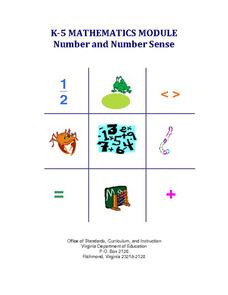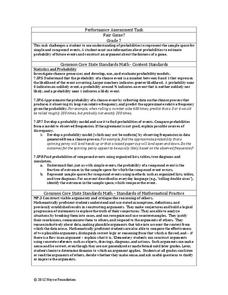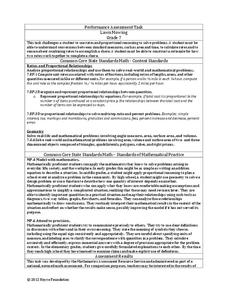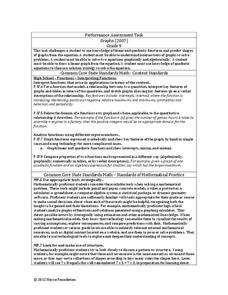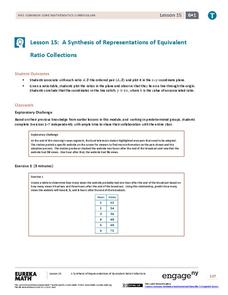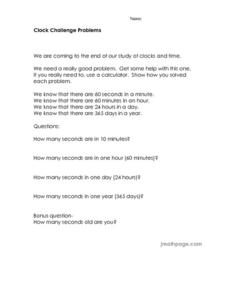Mathed Up!
Compound Measures
Compounding is dividing units. Pupils practice using compound measures such as units for speed and density to solve problems that range from straightforward speed problems to those requiring conversions. The last few items challenge...
EngageNY
Using Trigonometry to Find Side Lengths of an Acute Triangle
Not all triangles are right! Pupils learn to tackle non-right triangles using the Law of Sines and Law of Cosines. After using the two laws, they then apply them to word problems.
Mathed Up!
Simple Perimeter, Area, and Volume
Young mathematicians find the area and perimeter of shaded shapes on a grid of unit squares. The sheets challenge class members to find the volume of various solid prisms. Each questions also includes the total value of suggest...
EngageNY
Arcs and Chords
You've investigated relationships between chords, radii, and diameters—now it's time for arcs. Learners investigate relationships between arcs and chords. Learners then prove that congruent chords have congruent arcs, congruent arcs have...
Curated OER
K-5 Mathematics Module: Number and Number Sense
Reinforce number sense with a collection of math lessons for kindergarteners through fifth graders. Young mathematicians take part in hands-on activities, learning games, and complete skills-based worksheets to enhance proficiency...
Curated OER
Problem Solving: guess and check
In this guess and check worksheet, students use the strategy guess and check to solve math word problems containing one and two digit numbers. Students complete 6 problems.
EngageNY
Getting the Job Done—Speed, Work, and Measurement Units II
How fast is your class? Learners determine the amount of time it takes individuals to walk a given distance and calculate their speeds. Pupils solve distance, rate, and time problems using the formula and pay attention to the...
Bowland
Cats and Kittens
Can a cat have 2,000 descendants in 18 months? To determine if this claim is realistic, individuals must take different pieces of information into account when justifying their responses.
Noyce Foundation
Boxes
Teach your class to think outside the box. Scholars use the concept of equality to solve a problem in the assessment task. They determine how to use a scale to identify the one box out of a set of nine boxes that is heavier than the others.
Noyce Foundation
Fair Game?
The game should be fair at all costs. The mini-assessment revolves around the ability to use probabilities to determine whether a game is fair. Individuals determine compound events to calculate simple probabilities and make...
Charleston School District
Graphing Functions
How do letters and numbers create a picture? Scholars learn to create input/output tables to graph functions. They graph both linear and nonlinear functions by creating tables and plotting points.
Curated OER
Countdown Challenge: Multiplication by 10s
In this multiplication by 10s worksheet, 5th graders solve and complete 30 different problems that include multiples of 10. First, they complete the problems in the first section by multiplying each number given times 10. Then, students...
Curated OER
Countdown Challenge: Measuring Angles
In this measuring angles learning exercise, students draw hands in clock face to depict a given time. Next, they observe the angles created by the hands and determine the number of degrees. Students write proportions to solve the...
Simply Worksheets
Math in the Car - Easy
In this car math instructional activity, students play games of math in the car involving license plates, speed signs, and more. Students complete 4 problems.
Curated OER
Countdown Challenge: Experimental Probability
In this probability instructional activity, students compute the experimental probability of an event from given data. They give answers in fraction, decimal and percent form. Students compare the theoretical probability to the...
Inside Mathematics
Two Solutions
Many problems in life have more than one possible solution, and the same is true for advanced mathematics. Scholars solve seven problems that all have at least two solutions. Then three higher-level thinking questions challenge them to...
Noyce Foundation
Lawn Mowing
This is how long we mow the lawn together. The assessment requires the class to work with combining ratios and proportional reasoning. Pupils determine the unit rate of mowers and calculate the time required to mow a lawn if they work...
Inside Mathematics
Graphs (2007)
Challenge the class to utilize their knowledge of linear and quadratic functions to determine the intersection of the parent quadratic graph and linear proportional graphs. Using the pattern for the solutions, individuals develop a...
EngageNY
A Synthesis of Representations of Equivalent Ratio Collections
Make all the ratio representations fit together. The 15th segment in a series of 29 presents ratio problems to solve. Scholars use a variety of representations to respond to the questions. The problem set has pupils show how the...
Mr. Waynes clas
Kinematics Objectives
Accelerate young physicists' learning with this collection of problem-solving worksheets. Starting off by teaching students to identify the given information and variables in physics problems, this resource goes on to challenge them...
Teach Engineering
Solving Energy Problems
Here's your chance to save the world. The eighth lesson in a 25-part Energy Systems and Solutions unit has young scientists come up with ideas for individual or group projects. They identify ways to solve the energy crisis. Hope they...
Illustrative Mathematics
Money in the Piggy Bank
It's time to crack open that piggy bank and see what's inside. First, count up the pennies, nickels, dimes, and quarters, identifying what fraction of them are dimes. Then calculate the total value of the coins, writing another fraction...
Curated OER
Math Challenge
Students, using laminated math flash cards, play a review game with a partner. Also using Polyspots, they run, walk, or skip to the board with their answers.
Curated OER
Clock Challenge Problems
In this clock challenge worksheet, students solve 5 different problems that include the study of clocks and time. First, they determine the number of seconds in 10 minutes and then an hour. Then, students determine the number of seconds...






